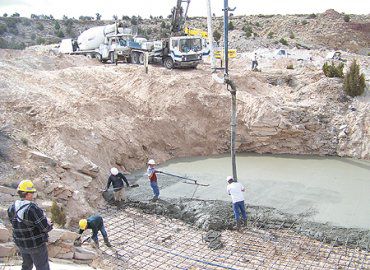The MK tunnels have long been a historical spot for Emery County residents. Most visitors to the area probably have no idea of their existence as they are not clearly visible from one of the many roads on the Swell. A project several years in the making is coming to fruition as work is being completed to close the MK tunnels and make them safe. Tony Gallegos from the Utah State Division of Oil, Gas and Mining has been involved with the MK tunnel project.
Work has been ongoing at the site since late February. The long horizontal tunnel will have a gate, on top of the first shaft will be a rebar gate with a concrete footer around it and the other two shaft openings towards the end of the tunnel will be partially backfilled and end with a concrete cap over it. There is nothing being done with the powder magazine in Buckhorn Draw. There is a horizontal portal that will be closed by a rock wall a short distance inside and the other shaft will have a pin grate.
Tony Gallegos, project manager, explained the separation of the San Rafael project and the MK Tunnel project into two separate projects. “In the San Rafael project, 173 mines openings have been proposed to be closed at a cost of $35,000. For the MK Tunnels, there are six openings which require closure at a cost of $164,000.
Gallegos explained the DOGM project will leave the opening known as the powder magazine for the MK Tunnels open for its historical value. It is a safe portal and is not in fractured, unsafe rock. At some of the other horizontal openings, manganol steel gates will be installed and may be recessed into the opening. The larger horizontal openings will be filled with block walls that will be covered with plaster using native soils to match the landscape colors.
The openings with something of interest to see will have the steel gates inserted so visitors can view the historical items.
As for the openings that are vertical into the ground, these will be backfilled with material from waste piles in the area and capped with concrete pads. “DOGM has engineered safety first, then considered the cultural and historic value, with consideration to sensitive species in the area,” said Gallegos. He stated the concrete pads will have drainage pipes to allow for run off with no further erosion.
Also included in the MK tunnel project is $10,000 in the project money to have an interpretive kiosk constructed to inform visitors of the historic value of the area.
The Emery County Historical Society went on a field trip a couple of years back and learned more on the history of the MK tunnels. The following is an excerpt from a story written at that time with information about the tunnels. Mervin Miles began the tour with a little history of the tunnels. “The general contractor for this project was the Department of Defense. The government wanted to test the rock for stability and feasibility for the building of a storage site. This began in the late 40s and continued until the mid 50s,” stated Miles.
“The tests were to determine if the rock in this area could withstand a bomb blast. Many tons of TNT were used to create the big tunnel. It goes back into the mountain about 300 feet with an off-shoot tunnel which is about 200 feet long. Several local men were involved in this project including, Jim Peacock, Lyle Crawford, Stewart Snow, and many others.
“In the 50s, when the crews were cleaning up the area, an Emery County gully washer came down and the flood waters rushed into the holes on the surface of the tunnel. One man was drowned, I’m not sure of his identity, and many pieces of equipment were also lost in the flood.
“In the Buckhorn, the powder magazine for this project was built. Further up the Buckhorn is where the camp was located with the living quarters for the people.
“This area has been considered a public safety hazard, due to the large holes in the top of the tunnels. The Bureau of Land Management has decided to reclaim the area to eliminate the dangerous situation. Following the blasts, it was determined that the rock in this area was too soft for the purpose of storage. The testing moved into Colorado and found a site suitable for the purpose and that location is NORAD today.
“For the reclamation of the project, the BLM has decided to fill in two of the three holes with small indentations remaining for the public to be able to visualize the holes. One hole will have grating installed so the hole remains visible.
The opening of the main tunnel will have recessed bars installed to allow visitors to see into the tunnel, but not have access into the unsafe areas.
“This reclamation project will resolve the safety and liability issues for the BLM,” said Miles.
The name MK tunnels comes from the contractor Morris and Knudsen who worked on the site.
MK Tunnels reclamation project: Long standing holes in the desert are filled

"Workers fill the old shaft with cement. Fill dirt was put down first and then the concrete cap. The cement will be covered with dirt from the area. A slight indentation will remain to show the location of the shaft."
